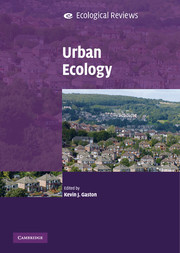Book contents
- Frontmatter
- Contents
- List of contributors
- Preface
- 1 Urban ecology
- 2 Urbanisation
- 3 Urban environments and ecosystem functions
- 4 Individual species and urbanisation
- 5 Species diversity and urbanisation: patterns, drivers and implications
- 6 Urbanisation and alien invasion
- 7 Interactions between people and nature in urban environments
- 8 Urban ecology and human social organisation
- 9 Urban ecology and human health and wellbeing
- 10 Bringing cities alive: the importance of urban green spaces for people and biodiversity
- 11 Integrating nature values in urban planning and design
- 12 Urban futures
- Index
- References
7 - Interactions between people and nature in urban environments
Published online by Cambridge University Press: 05 June 2012
- Frontmatter
- Contents
- List of contributors
- Preface
- 1 Urban ecology
- 2 Urbanisation
- 3 Urban environments and ecosystem functions
- 4 Individual species and urbanisation
- 5 Species diversity and urbanisation: patterns, drivers and implications
- 6 Urbanisation and alien invasion
- 7 Interactions between people and nature in urban environments
- 8 Urban ecology and human social organisation
- 9 Urban ecology and human health and wellbeing
- 10 Bringing cities alive: the importance of urban green spaces for people and biodiversity
- 11 Integrating nature values in urban planning and design
- 12 Urban futures
- Index
- References
Summary
Since the dawn of human civilisation, people have interacted with nature, most notably to harness the resources that have fuelled the human enterprise (Vitousek et al. 1997). The sheer rate and scale of human appropriation of natural resources has precipitated a biodiversity crisis currently being manifested in rapid rates of species extinctions, extensive transformation of the structure and function of ecosystems, and rapid alterations to the Earth's climate (Vitousek et al. 1986; Pimm & Raven 2000). The biodiversity crisis is a result of human activity, so the solutions to it will depend largely on human actions, on understanding and enhancing the way that we all interact with nature (Collins et al. 2000; Ehrlich 2002). Because most people on the planet live in towns and cities, the majority of our daily interactions with nature take place in urban environments, and this has led to a recent upsurge of interest in the dynamics of these relationships (Bradshaw & Bekoff 2000; Miller & Hobbs 2002; Pyle 2003; Saunders et al. 2006). Despite the manifest impoverishment of the natural environment in urban areas, or perhaps because of it, many urban dwellers seek out interaction with nature in some form, for example by visiting a local green space, or feeding backyard birds. Yet our understanding of these interactions is nascent, principally because their study requires work across several disciplinary boundaries (Alberti et al. 2003; Braun 2005). For example, ecologists often lack the interest or the tools to study people (Collins et al. 2000).
- Type
- Chapter
- Information
- Urban Ecology , pp. 134 - 171Publisher: Cambridge University PressPrint publication year: 2010
References
- 27
- Cited by



